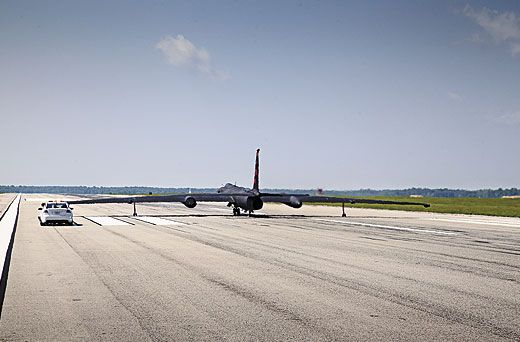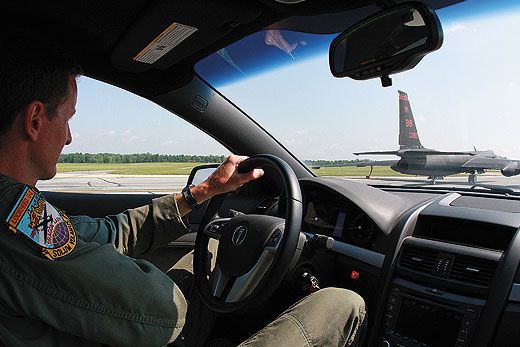Wingman in a Pontiac
It takes two to land the dragon lady.
/https://tf-cmsv2-smithsonianmag-media.s3.amazonaws.com/filer/Wingman_in_a_Pontia_2_FLASH.jpg)
Air Force Captain Dan Watson redlines the throttle of his Pontiac G8 GT, and the 361-horsepower V-8 engine sends him hurtling down Runway 15 at California’s Beale Air Force Base at 100-plus mph. Watson (at Air Force request, names have been changed for security purposes) angles left off a taxiway to intercept a Lockheed U-2 that’s about to land.
He keys the microphone attached to the radio: “Forty feet,” he says as the U-2S, flown by Captain Gary Milder, soars past at 80 mph. “Thirty. Twenty. Ten.” Watson slots in 10 yards behind the spindly black aircraft and slows to match its pace. “Five. Three. Two. One. One and a half. One.”
Watson’s tone is detached, clinical. Judging from the antic fluttering of the elevators and rudder, it’s clear that Milder is dancing with a twitchy partner. “The U-2 is a real stick-and-rudder airplane,” he explains later. “Plus, it’s like a giant windsock. So down low, it’s a bear.”
Kelly Johnson and his team at the Lockheed Skunk Works designed the U-2 to fly, not to land, and its glider-like wings, spanning 105 feet on later models, generate so much lift that during a 1955 taxi test, pilot Tony LeVier inadvertently left the ground. With its ability to loiter for more than 10 hours, the U-2 has been performing reconnaissance duty for the Air Force—and the CIA—ever since.
The U-2 is optimized for high altitudes, where Air Force Captain Jay Jones, an instructor pilot at Beale, says “it handles like a sports car.” But the mechanical flight-control system lacks hydraulic assist, so in the landing pattern, it feels more like an 18-wheeler.
Landing the legendary spyplane is especially challenging because it’s fitted with skateboard-style landing gear rather than a conventional tricycle arrangement. (During taxiing and takeoffs, the wings are supported by a pair of outriggers called pogos, and after landing, the U-2 comes to rest on a wingtip protected by a titanium skid plate.) New pilots are taught to fly down a three-degree glideslope until the tires are two feet off the runway. They hold it there until the wings stall—it’s virtually impossible to get the U-2 on the ground until they do—allowing the airplane to touch down on the tailwheels, then ease onto the main gear.
With its slender profile, the aircraft is tetchy in crosswinds, and if the landing gear isn’t pointing straight ahead, the U-2 will veer off the runway. Also, the pilot’s vision is compromised by the cumbersome pressure suit required at high altitudes—the dumb suit, Jones calls it, because “wearing it reduces your IQ by half.”
With that limitation, plus the U-2’s ungainly dimensions and skittish characteristics, little wonder that applicants get a severe case of jitters about their three evaluation flights, just one requirement of a torturous vetting process they undergo before being allowed to fly a U-2.
Joining the program is just the first step in learning how to keep the airplane right side up. Every pilot, no matter how good, needs help when he or she is on or near the ground. So whenever a U-2 taxis or lands, another U-2 pilot accompanies it in a mobile—Air Force parlance for a car. Because every flight requires a mobile—think of it as a ground-based wingman—all U-2 fliers are trained as such. “It’s like having an extra brain and another set of eyes to help prevent you from screwing up,” Jones explains.
The mobile program began in the 1950s with Ford station wagons. Eventually, they were replaced by Chevy El Caminos, then 5.0-liter Mustangs equipped like California Highway Patrol cruisers, then Camaros with police-performance packages. A few years ago, the Air Force went to Pontiac GTOs and G8 GTs, but they’re already due for replacement by the 426-horsepower Camaro SS. “Every once in a blue moon a car will break while chasing,” says Jones. “We’ve had a car throw a cylinder on the runway, and one had the transmission lock up.” Of the fleet of 12 cars, Jones says, “they don’t have many miles on them, but they’re all zero-to-120-mph.”
This afternoon, Milder is simply shooting touch-and-go landings to stay current. This particular landing is a simulated engine flame-out, and he’s fighting gusty crosswinds that are making the airplane float sideways just above the runway.
“Two feet,” Watson radios, speeding along in Milder’s wake. “One. Left rudder. One and a half. One. Left rudder. Inches. Inches.” The rear tires touch and with a puff of smoke the airplane settles gently on the mains. “Very nice,” Watson says as Milder applies takeoff power to the General Electric F118-101 turbofan. Fifteen seconds later, the aircraft is merely a speck in sky.
To position the G8 for Milder’s next pass, Jones whips around and blasts down the runway at 140 mph. “This sure beats sitting at a desk,” he says, “but I’d rather be flying the airplane.”
Preston Lerner, a frequent contributor, wrote “The Kids Are Trying to Crash” (Dec. 2011/Jan. 2012), which chronicled innovations in radiocontrol model aircraft.

